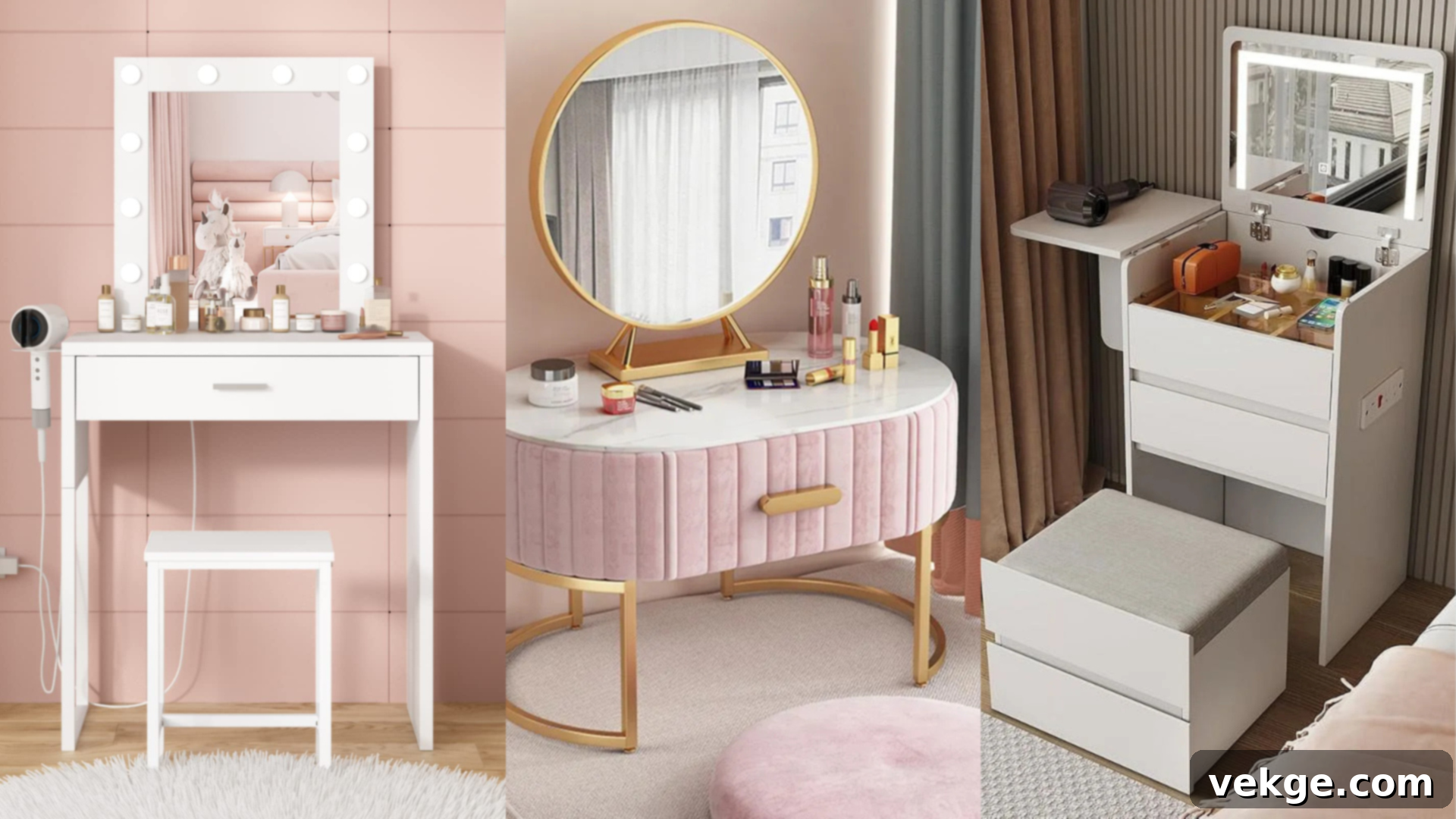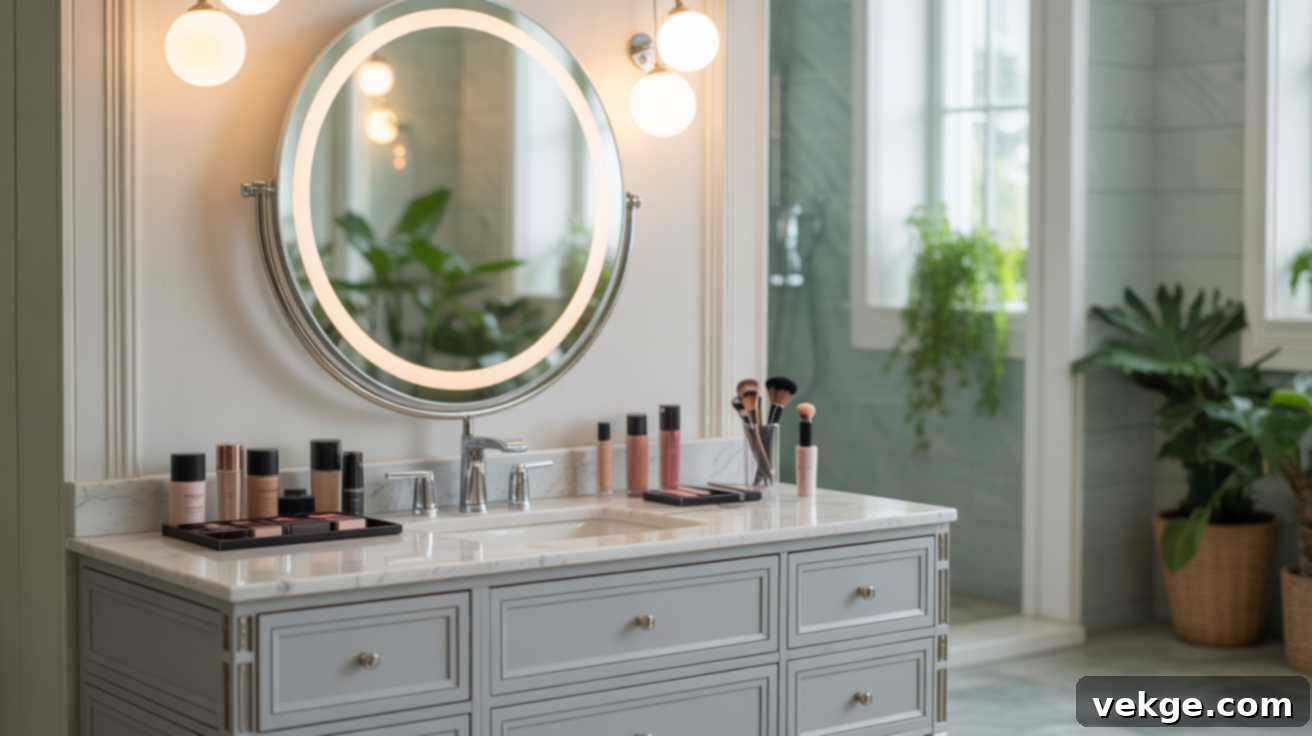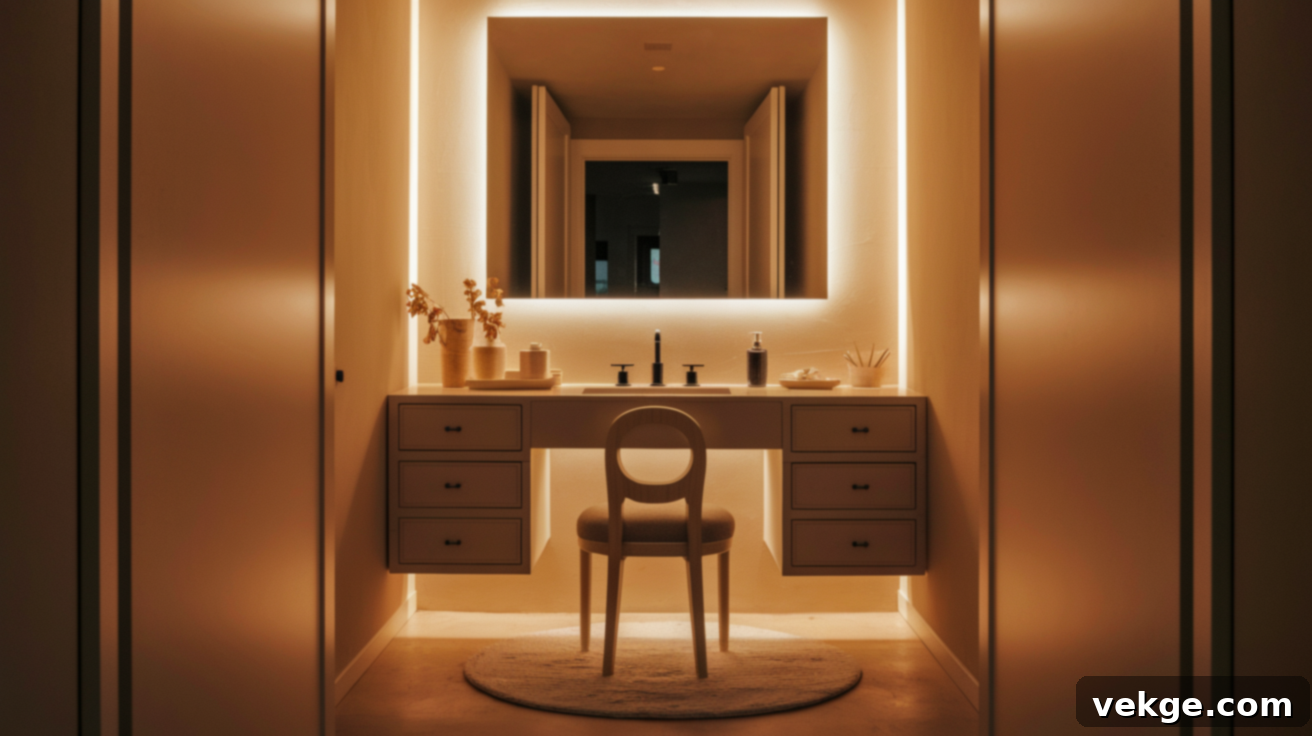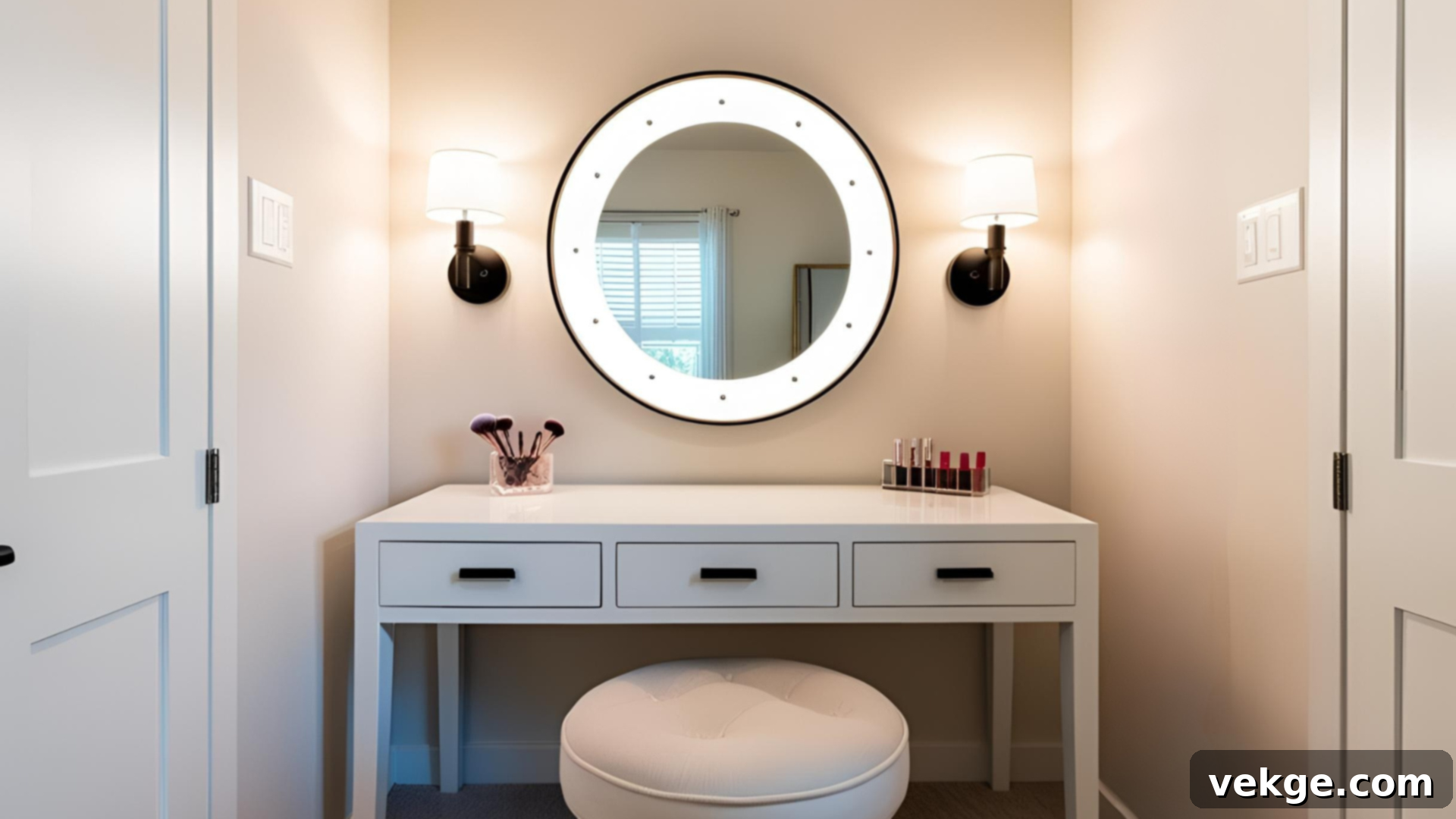Find Your Perfect Fit: The Ultimate Guide to Makeup Vanity Height for Comfort & Style
Have you ever found yourself hunching over your makeup vanity or reaching uncomfortably high for your brushes? The height of your makeup station isn’t just a design choice; it’s a critical factor for your comfort, posture, and the efficiency of your daily beauty routine. A poorly matched vanity height can lead to backaches, neck strain, and even frustrating lighting issues that disrupt your flawless application.
This comprehensive guide delves into every essential detail you need to know. We’ll explore standard and ADA-compliant measurements, discuss the perfect stool pairings, share expert tips on mirror placement and optimal lighting, and even offer clever tricks for DIY setups. Our goal is to empower you with the knowledge to select or create a makeup vanity that feels custom-made just for you, transforming your daily ritual into a truly comfortable and enjoyable experience.
Ready to unlock the secrets to your ideal beauty space? Let’s get started and discover your perfect match.
Understanding Standard Makeup Vanity Height for Optimal Comfort

Achieving the correct vanity height is paramount for making your daily beauty routines not only easier but significantly more comfortable. Since most individuals prefer to sit while applying makeup, pairing the vanity with an appropriate stool or chair height is crucial for maintaining good posture and preventing discomfort. The right setup ensures that your arms and shoulders are relaxed, your feet are flat on the floor, and your vision is perfectly aligned with your mirror.
Below, we’ll break down the most common vanity height ranges, explaining when each is most effective and how to determine which range best suits your personal needs and preferences.
Common Height Ranges for Makeup Vanities
The ideal height of your makeup vanity largely depends on how you intend to use it and who will be using it. A setup designed for a seated adult will differ significantly from one intended for a child, or for someone who prefers to stand during their routine. Considering these usage scenarios will guide you to the most ergonomic and practical choice.
- 30–34 inches (Approx. 76-86 cm): This is the most common and versatile height range, specifically designed for comfortable seated use with a standard chair or a dedicated vanity stool. It allows most adults to rest their elbows naturally on the surface without shrugging their shoulders, making it ideal for detailed makeup application.
- 24–28 inches (Approx. 61-71 cm): A shorter vanity height is often preferred for children’s spaces, or for specific standing setups where the user might only be leaning in briefly. While less common for adult seated use, it can be suitable for very low stools or specialized ergonomic chairs.
- 36 inches (Approx. 91 cm): Often referred to as “counter-height,” this measurement works exceptionally well if you primarily plan to stand while doing your makeup, or if you prefer to use a taller counter-height stool. It’s also a good option if your vanity doubles as a bathroom counter extension.
Pairing Vanity Height with Recommended Stool Heights
Selecting the right stool or chair is just as vital as choosing the vanity itself. The perfect pairing ensures you can sit comfortably, reach all your makeup essentials without straining, and maintain an upright, relaxed posture. Use the following chart as a quick reference to match your vanity height with a suitable seating option:
|
Vanity Height |
Recommended Stool/Chair Height |
|
24–28 inches (61-71 cm) |
12–15 inches (30-38 cm) |
|
30–32 inches (76-81 cm) |
16–18 inches (41-46 cm) |
|
34–36 inches (86-91 cm) |
20–24 inches (51-61 cm) (counter-height stool) |
A simple test for the right match: when seated, your elbows should rest comfortably about 1 inch (2.5 cm) above the tabletop. This slight elevation allows for natural arm movement and a clear view of your face in the mirror.
ADA-Compliant Vanity Height for Accessibility
When designing for accessibility, particularly for individuals using wheelchairs or other mobility aids, the height of the vanity surface is only one piece of the puzzle. Equally important is providing adequate clear knee and toe space underneath. The Americans with Disabilities Act (ADA) has established clear guidelines to ensure comfort, safety, and independence. Adhering to these standards benefits everyone by promoting universal design.
- Vanity Surface Height: 28–34 inches (71-86 cm): This range accommodates various users, ensuring the surface is accessible without being too high for seated individuals or too low for those standing.
- Clear Knee Space Requirements: For proper wheelchair access, the area beneath the vanity must be at least 27 inches (68.5 cm) high, 30 inches (76 cm) wide, and 19 inches (48 cm) deep. This critical clearance allows a wheelchair user to maneuver comfortably and approach the vanity directly without obstruction, ensuring full access to the surface and mirror.
Incorporating ADA principles into your vanity design not only meets legal requirements but also fosters an inclusive environment, making your space functional and welcoming for all.
Key Factors Influencing Your Ideal Vanity Height
Choosing the perfect makeup vanity height isn’t a one-size-fits-all decision. Several crucial factors interact to create your ideal setup. Considering the type of seating you’ll use, the placement and style of your mirror, and your unique personal comfort preferences will guide you toward a vanity that truly enhances your daily routine. Overlooking these small details can significantly impact the ease and pleasure of your beauty station.
1. The Impact of Seating Type on Vanity Height
Your choice of seating is perhaps the most influential factor in determining the optimal vanity height. The goal is always to achieve a neutral, comfortable posture where your body is aligned and relaxed.
- Standard Vanity Stool or Chair (16-18 inches high): These pair exceptionally well with vanities that are 30 to 32 inches tall. This combination ensures your feet can rest flat on the floor (or a footrest), and your elbows can comfortably rest on the tabletop, creating a stable and ergonomic workspace.
- Low Stool or Bench (12-15 inches high): If you prefer a very low stool or a floor cushion, you might find a shorter vanity, perhaps in the 24 to 28-inch range, more suitable to maintain a natural elbow angle.
- Tall Counter Stools or Bar Stools (20-24 inches high): For those who prefer a more elevated position, or if your vanity is integrated with a taller counter, a vanity closer to 36 inches will be ideal. Ensure the stool allows for a comfortable leg rest or foot ring.
- Adjustable Office Chairs or Specialty Vanity Chairs: These offer the most flexibility. An adjustable seat allows you to fine-tune your height to various vanity surfaces, making them an excellent option if multiple people with different heights will use the vanity, or if you simply want the ability to customize your posture.
Regardless of your seating choice, always ensure that when seated, your elbows naturally rest at tabletop level with your shoulders relaxed. This prevents tension in your neck and upper back, making long makeup sessions much more comfortable.
2. Mirror Type and Strategic Placement
The type and placement of your mirror are intrinsically linked to your vanity height, directly affecting visibility and comfort. An improperly positioned mirror can force you into awkward postures, leading to neck strain and an imperfect view for makeup application.
- Wall-Mounted Mirrors: These are fixed, meaning your vanity height must be precisely aligned with your seated eye level. The center of the mirror should ideally be at your eye level when you’re seated at the vanity. If the mirror is too high or too low, you’ll find yourself craning your neck, which can cause discomfort over time.
- Vanities with Built-In or Freestanding Mirrors: These offer greater flexibility. Many built-in mirrors can tilt or swivel, allowing for minor adjustments regardless of your exact height or seating position. Freestanding vanity mirrors can be moved or replaced more easily to suit your needs. For best results, position the mirror so that your entire face and upper torso are visible without bending or stretching.
- Consider Mirror Size and Proximity: A larger mirror might seem more convenient, but ensure it doesn’t overwhelm the space or force you to lean too far back. The mirror should be close enough for detailed work but far enough to give you a full perspective of your face.
The goal is to achieve an effortless gaze into the mirror, ensuring you can apply makeup with precision and comfort, free from any postural strain.
3. Prioritizing Personal Comfort and Ergonomics
Ultimately, the “right” vanity height is the one that feels most comfortable and natural for you. Ergonomics plays a crucial role here, focusing on designing a workspace that minimizes discomfort and maximizes efficiency for the user.
- Neutral Posture is Key: Your arms should rest naturally on the vanity surface without causing your shoulders to raise or hunch. Your forearms should be roughly parallel to the floor, and your wrists should be straight.
- Spinal Alignment: If the vanity is too high, you might elevate your shoulders and strain your neck. If it’s too low, you’ll likely hunch over, putting pressure on your lower back. Your spine should maintain its natural S-curve, feeling relaxed and supported.
- Feet Position: Your feet should be flat on the floor or comfortably supported by a footrest. Dangling feet can lead to pressure points and poor circulation.
- Testing Before Committing: It’s vital to test your setup before making a final purchase or building a custom piece. Use stacks of books or temporary risers to simulate different vanity heights with your chosen chair. Spend a few minutes at each simulated height, mimic your usual routine, and pay attention to how your body feels. This practical test can save you from costly mistakes and ensure lasting comfort.
A vanity that perfectly aligns with your body’s natural posture will transform your daily routine from a chore into a moment of comfortable self-care.
The Importance of Vanity Depth and Ample Knee Space
While height often takes center stage, the depth of your vanity and the amount of clear knee space underneath are equally critical for a functional and comfortable setup. A vanity that’s too shallow can feel cramped and leave little room for your products, whereas one that’s excessively deep might waste valuable space and make reaching items difficult. Optimal depth and knee space ensure you can move comfortably, store your makeup efficiently, and sit with excellent posture, especially if your vanity is a frequently used station.
Achieving Ideal Vanity Depth

For most makeup vanities, an ideal depth ranges from 14 to 20 inches (approximately 35 to 50 cm). This range strikes a perfect balance, offering several key benefits:
- Easy Access to Items: Within this depth, all your makeup and tools are within easy reach without requiring you to lean too far forward or stretch uncomfortably.
- Sufficient Elbow Room: It provides enough surface area for comfortable elbow movement during application, preventing a cramped feeling.
- Efficient Space Utilization: This depth keeps the vanity compact enough for most rooms while still offering adequate surface area.
- Storage Potential: It allows for practical storage solutions, whether you prefer organizing trays on top or drawers underneath.
If you’re working with a smaller room or a tight nook, opting for the lower end of this range (14-16 inches) can maximize your available space. Conversely, if you have a larger room and an extensive makeup collection, a deeper vanity (18-20 inches) can provide more surface area for product display and additional under-counter storage options.
Ensuring Ample Knee Space for Comfort

If your makeup vanity is designed for seated use, the clear space underneath for your legs and knees is an absolute necessity for comfort and good posture. Without adequate knee space, you might find yourself sitting awkwardly at an angle, constantly bumping your knees, or being unable to pull your chair close enough to the vanity – all of which detract from the user experience.
A well-designed vanity should offer at least 24 to 30 inches (61-76 cm) wide and 19 inches (48 cm) deep of clear knee space. This generous clearance ensures that you can pull your chair or stool in fully, allowing your body to be properly aligned with the vanity surface. It makes a significant difference in how comfortable and truly usable your vanity feels during extended periods of application.
For even greater comfort and compatibility with a wide range of standard chairs and stools, it’s recommended that the clear space under the vanity is at least 27 inches (68.5 cm) high. This height prevents your legs or chair arms from hitting the underside of the vanity, ensuring a smooth and unobstructed seating experience.
Always remember to account for any drawers, shelves, or structural elements that might protrude into the knee space when measuring or designing your vanity.
Optimizing Lighting, Visibility, and Light Fixture Height
Beyond height and space, effective lighting is arguably the most crucial element for any makeup vanity. Poor lighting—whether too dim, too bright, or incorrectly positioned—can create unflattering shadows, cause glare, and lead to inaccurate makeup application. The goal is to illuminate your face evenly and naturally, mimicking ideal conditions for the most precise results.
Strategic Placement of Light Fixtures
To achieve the best lighting, avoid overhead-only fixtures, which cast harsh downward shadows that emphasize imperfections. Instead, focus on illuminating your face from the front and sides:
- Wall Sconces: These are a classic and highly effective choice. Install one sconce on each side of your mirror, roughly at face height when you are seated. The ideal installation height for wall sconces is typically between 60 and 66 inches (152-168 cm) from the floor. This symmetrical placement ensures even light distribution, eliminating shadows and providing a balanced view for makeup application.
- Built-in LED Strips or Hollywood-Style Bulbs: If your vanity mirror features integrated LED strips or a series of bulbs around its frame, ensure they are spaced evenly to provide consistent coverage. These designs are excellent at minimizing shadows by surrounding your face with light.
- Avoid Backlighting: Never rely solely on a light source behind you (e.g., a window or lamp) as your primary makeup light, as it will cast your face in shadow.
Choosing the Right Light Temperature and Brightness
The quality of light is just as important as its placement:
- Color Temperature: Opt for bulbs that produce a soft white, neutral white, or “daylight” tone. These typically have a color temperature between 3500K and 5000K (Kelvin). These tones closely mimic natural daylight, allowing you to apply makeup accurately and see how it will appear in various real-world lighting conditions. Avoid overly warm (yellowish) or cool (bluish) lights, which can distort colors.
- Brightness (Lumens) and Dimmers: Aim for sufficient brightness without creating harsh glares. For vanity lighting, a total of 2000-4000 lumens distributed evenly is often recommended. Consider installing a dimmer switch, which gives you the flexibility to adjust the light intensity based on the time of day, natural light availability, and specific makeup tasks. This adaptability is invaluable for achieving perfect results.
- Color Rendering Index (CRI): Look for bulbs with a high CRI, ideally 90 or above. CRI measures how accurately a light source reveals the true colors of objects compared to natural sunlight. A high CRI ensures that your makeup colors appear true-to-life, preventing any surprises when you step outside.
By thoughtfully considering fixture placement, color temperature, and brightness, you can create a perfectly illuminated vanity space that enhances your visibility and elevates your entire beauty routine.
Customizing Your Vanity Height for a Truly Personalized Fit
Standard measurements provide a great starting point, but not everyone fits the mold perfectly. Whether you’re taller or shorter than average, use a specific chair height, or if your vanity will be a shared space, custom height adjustments can make an immense difference in comfort and functionality. Custom or adjustable vanities offer unparalleled flexibility, ensuring your setup is perfectly tailored to your unique needs. This section explores how to adapt your vanity to fit you, without overcomplicating the process.
Exploring Adjustable or Modular Vanities
For those seeking ultimate adaptability, adjustable or modular vanities are an ideal solution, particularly for shared spaces, growing children, or individuals whose needs may change over time. These innovative designs offer various mechanisms for altering the vanity’s height:
- Swappable Legs: Some vanities come with multiple sets of legs of different lengths, allowing you to easily adjust the overall height by swapping them out. This is a straightforward, non-permanent solution.
- Platform Risers or Attachable Blocks: For existing vanities, specialized risers or aesthetically pleasing blocks can be placed under the vanity legs to increase its height. Ensure these are stable and securely attached to prevent wobbling.
- Adjustable Desk Bases: These modern bases, often used for standing desks, can be paired with a custom vanity top. They typically feature electric motors that allow for smooth, precise height adjustments with the touch of a button, offering the greatest range and convenience. This is an excellent option for a truly ergonomic and flexible vanity.
- Modular Components: Some vanity systems are designed with modular components that can be reconfigured or added to, allowing for height adjustments as well as changes in storage and surface area.
Investing in an adjustable or modular setup provides you with complete control over your comfort, eliminating the need to commit to one fixed height. They are a smart, future-proof choice if you’re still refining your ideal setup or planning a vanity for multiple users in your home.
Practical Tips for Successful DIY Vanity Setups
Building or modifying your own vanity offers the ultimate customization. With a few thoughtful steps, your DIY vanity can feel professionally custom-made just for you:
- Start with Your Seating: Sit comfortably in your chosen chair or stool with your feet flat on the floor. Maintain good posture.
- Measure Your Elbow Height: With your shoulders relaxed and forearms parallel to the floor, measure the distance from your elbow to the floor.
- Calculate Ideal Tabletop Height: Subtract one to two inches (2.5-5 cm) from your elbow height measurement. This slight reduction ensures your arms can rest comfortably on the surface without shrugging your shoulders. For example, if your elbow height is 29 inches, your ideal tabletop height would be 27-28 inches.
- Prototype and Test: Before cutting any wood or drilling holes, create a temporary mockup. Use stacks of sturdy books, cardboard boxes, or adjustable saw horses to simulate different heights. Place your mirror and any desired lighting, then sit down and mimic your daily routine. Pay close attention to how your body feels, especially your neck, shoulders, and back. Adjust the height of your prototype until it feels perfectly natural and comfortable.
- Factor in Mirror and Lighting Placement: As you’re prototyping, ensure the mirror is centered at your seated eye level and that any planned lighting provides even, shadow-free illumination. Adjust these elements in conjunction with the vanity height.
- Consider Materials and Stability: Choose durable materials for your DIY project that can withstand daily use. Ensure the vanity is stable and won’t wobble, especially if you’re adding risers or extensions.
- Don’t Forget Knee Space: Double-check that your design includes ample knee space (at least 27 inches high, 24-30 inches wide, and 19 inches deep) for comfortable seating.
With a little patience and careful planning, your DIY vanity will not only meet your aesthetic preferences but also provide an ergonomically sound and highly personalized beauty station.
Conclusion: Crafting Your Perfect Beauty Haven
The journey to finding the right makeup vanity height is an investment in your comfort, health, and daily well-being. A thoughtfully designed and perfectly fitted vanity transforms your beauty space into a sanctuary—a place where you can sit comfortably, focus without strain, and enjoy your routine every single day. We’ve explored the essential elements: from ideal height ranges and the crucial role of seat pairing to understanding knee space requirements, optimizing mirror placement, mastering lighting, and embracing customization.
Whether you’re embarking on the exciting process of buying a new vanity, modifying an existing one, or building your dream station from scratch, remember that comfort is paramount. Consider how you sit, the tools you use, and the frequency of your vanity use. A well-proportioned vanity supports good posture, reduces physical strain, and ultimately empowers you to feel more relaxed, focused, and confident in your daily beauty endeavors. It’s about creating a personal space that truly works for you.
Ready to discover more practical tips and expert advice for creating a home that feels perfectly tailored to your life? Explore our other home setup blogs and design guides. They’re crafted to help you make every corner of your home feel just right.
